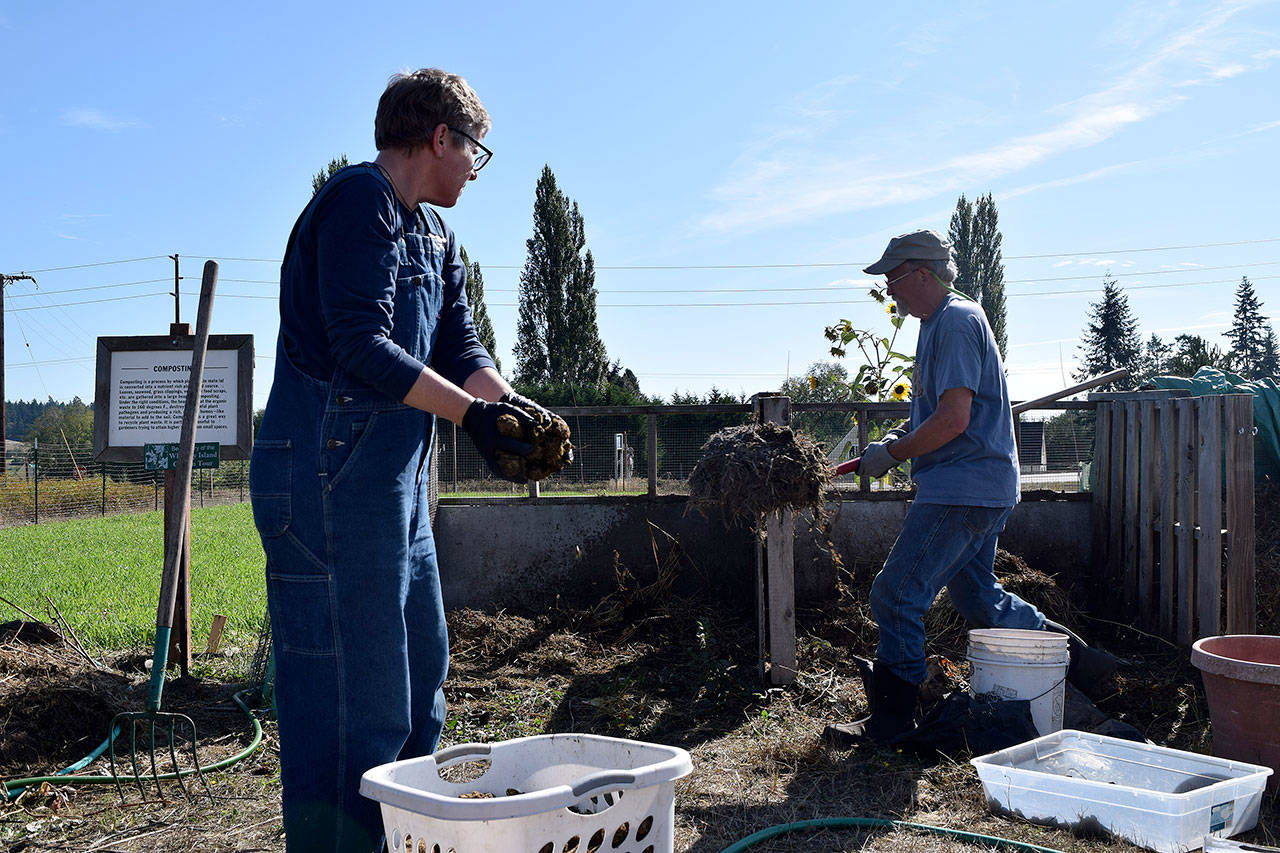Those who compost are well aware that it’s a lengthy process to produce the goods. It typically takes about a year before one has something ideal for their plants.
This past weekend, though, a Washington State University Master Gardener was eager to show off a shortcut to nutrient-rich compost known as “hot compost.”
“Regular composting, A.K.A. ‘cold composting,’ takes months and can only be slightly sped up by shoveling compost on the bottom to the top, but even that still takes a year,” Master Gardener Tom Vincent said. “The idea with hot compost is you build the perfect environment for bacteria, it goes nuts and builds compost in a shorter time.”
Vincent led a hands-on workshop Sunday afternoon at the South Whidbey Tilth campus on the less-used composting method. Eager to share the efficient and time-conserving procedure with others, Vincent came prepared with buckets of compost materials set aside to build a large heap with curious workshop guests. Over the course of an hour, those attending the workshop built a hot compost heap while learning the science behind what speeds up the composting process.
By the end of the workshop, people could already see the fruit of their labor in action, as the pile began to steam. Vincent hopes to raise awareness of the method and continues to urge people on South Whidbey to compost at home. This, he hopes, will make things a little easier and less time-consuming.
“It’s not rocket science, it’s more like alchemy,” Vincent said. “The soil you get from hot composting is gold for gardens. For example, we held a soil class yesterday and when the instructor put this soil under a microscope he said it was the best soil he’d seen in a while.”
The basic principles of hot composting is to build a heap containing the correct ratio of carbon to nitrogen, and later adding enough moisture and oxygen to make the bacteria in the soil “go crazy” with activity. It’s something people can do at home without some sort of compost bin. If done correctly, the steaming pile will maintain a high temperature, even if it’s exposed to frigid winter weather. The temperature kills pathogens and weed seeds, making it ideal for a garden.
According to Vincent, a hot compost pile should hit between 120 and 160 degrees Fahrenheit.
The proper ratio of carbon to nitrogen is “between 25 to one and 30 to one,” according to Vincent. What that means is in order to correctly get hot compost, one needs to layer materials high in carbon followed by materials high in nitrogen, and so on. Generally, dried materials such as wood chips, corrugated cardboard and wheat straw are examples of materials high in carbon. Vincent used materials such as coffee grounds, cow and chicken manure and vegetable produce to add materials high in nitrogen.
During the workshop, Vincent led curious guests through the steps of building a hot compost heap. Starting with a base of straw and hay, which are high in carbon and airy enough for the pile to breathe, people then covered a layer with a nitrogen rich substance.
To top it all off, the group added finished compost, which helps kick start the process.
According to Vincent, people should wait three to four days for the pile to heat up before turning the heap “every second day for 14 days.” After that 14-day window, he suggests covering the pile to let it “cure” for another 14 days. What’s left afterwards is gold for plants.
“This is a process that is useful for farmers and gardeners on Whidbey, since it’s a way to get good soil quickly,” Susan Prescott, South Whidbey Tilth president, said. “We have relatively poor soil in the area because of the glaciers, so it’s a great way to get very good soil that you need within a month.”
The heat generated comes from the bacteria busy at work. Vincent says if a thermometer reads the temperature as dropping below 120 degrees, add matter high in nitrogen when turning the pile. If it starts to overheat, add materials high in carbon.
For Vincent and Prescott, making finished compost in a shorter amount of time only makes it easier for one to compost on a regular basis. They hope South Whidbey continues to compost more widely, and this could represent a step in the right direction.
“It’s quick and you don’t have to spend money on materials,” Prescott said. “It’s more a matter of if you and your animals can produce that much material. But if you do, you’ll end up with great soil.”



